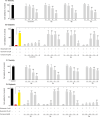Azobioisosteres of Curcumin with Pronounced Activity against Amyloid Aggregation, Intracellular Oxidative Stress, and Neuroinflammation
- PMID: 33666306
- PMCID: PMC8048673
- DOI: 10.1002/chem.202005263
Azobioisosteres of Curcumin with Pronounced Activity against Amyloid Aggregation, Intracellular Oxidative Stress, and Neuroinflammation
Abstract
Many (poly-)phenolic natural products, for example, curcumin and taxifolin, have been studied for their activity against specific hallmarks of neurodegeneration, such as amyloid-β 42 (Aβ42) aggregation and neuroinflammation. Due to their drawbacks, arising from poor pharmacokinetics, rapid metabolism, and even instability in aqueous medium, the biological activity of azobenzene compounds carrying a pharmacophoric catechol group, which have been designed as bioisoteres of curcumin has been examined. Molecular simulations reveal the ability of these compounds to form a hydrophobic cluster with Aβ42, which adopts different folds, affecting the propensity to populate fibril-like conformations. Furthermore, the curcumin bioisosteres exceeded the parent compound in activity against Aβ42 aggregation inhibition, glutamate-induced intracellular oxidative stress in HT22 cells, and neuroinflammation in microglial BV-2 cells. The most active compound prevented apoptosis of HT22 cells at a concentration of 2.5 μm (83 % cell survival), whereas curcumin only showed very low protection at 10 μm (21 % cell survival).
Keywords: amyloid beta; bioisosterism; natural products; neuroprotectivity; replica-exchange molecular dynamics.
© 2021 The Authors. Chemistry - A European Journal published by Wiley-VCH GmbH.
Conflict of interest statement
The authors declare no conflict of interest.
Figures







Similar articles
-
Curcumin inhibits formation of amyloid beta oligomers and fibrils, binds plaques, and reduces amyloid in vivo.J Biol Chem. 2005 Feb 18;280(7):5892-901. doi: 10.1074/jbc.M404751200. Epub 2004 Dec 7. J Biol Chem. 2005. PMID: 15590663
-
Computational Evaluation of Interaction Between Curcumin Derivatives and Amyloid-β Monomers and Fibrils: Relevance to Alzheimer's Disease.J Alzheimers Dis. 2021;82(s1):S321-S333. doi: 10.3233/JAD-200941. J Alzheimers Dis. 2021. PMID: 33337368 Free PMC article.
-
Targeting the multifaceted neurotoxicity of Alzheimer's disease by tailored functionalisation of the curcumin scaffold.Eur J Med Chem. 2023 Apr 5;252:115297. doi: 10.1016/j.ejmech.2023.115297. Epub 2023 Mar 21. Eur J Med Chem. 2023. PMID: 36996713
-
Post-Ischemic Brain Neurodegeneration in the Form of Alzheimer's Disease Proteinopathy: Possible Therapeutic Role of Curcumin.Nutrients. 2022 Jan 7;14(2):248. doi: 10.3390/nu14020248. Nutrients. 2022. PMID: 35057429 Free PMC article. Review.
-
Curcumin: A small molecule with big functionality against amyloid aggregation in neurodegenerative diseases and type 2 diabetes.Biofactors. 2021 Jul;47(4):570-586. doi: 10.1002/biof.1735. Epub 2021 Apr 24. Biofactors. 2021. PMID: 33893674 Review.
Cited by
-
Dual-Acting Small Molecules: Subtype-Selective Cannabinoid Receptor 2 Agonist/Butyrylcholinesterase Inhibitor Hybrids Show Neuroprotection in an Alzheimer's Disease Mouse Model.J Med Chem. 2023 May 11;66(9):6414-6435. doi: 10.1021/acs.jmedchem.3c00541. Epub 2023 Apr 26. J Med Chem. 2023. PMID: 37127287 Free PMC article.
-
Inhibition of β-Amyloid Aggregation in Alzheimer's Disease: The Key Role of (Pro)electrophilic Warheads.ACS Med Chem Lett. 2022 Oct 10;13(11):1812-1818. doi: 10.1021/acsmedchemlett.2c00410. eCollection 2022 Nov 10. ACS Med Chem Lett. 2022. PMID: 36385935 Free PMC article.
References
-
- E. Babusikova, A. Evinova, J. Jurecekova, M. Jesenak, D. Dobrota in Advanced Understanding of Neurodegenerative Diseases, IntechOpen, 2011.
-
- None
-
- Glenner G. G., Wong C. W., Biochem. Biophys. Res. Commun. 1984, 120, 885–890; - PubMed
-
- Haass C., Selkoe D. J., Nat. Rev. Mol. Cell Biol. 2007, 8, 101–112. - PubMed
MeSH terms
Substances
Grants and funding
LinkOut - more resources
Full Text Sources
Other Literature Sources
Medical

